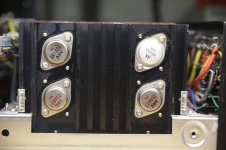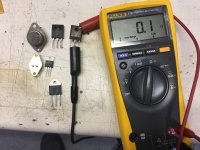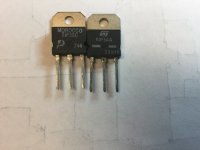I'm restoring an old Kenwood integrated amp and noticed that one of output the transistors has a different nomenclature than its mate. I would like to have a matching set as a back-up because I'm assuming that if these fail in 10 years or so, replacements will be much more difficult to find.
Any guidance would be appreciated.
1 pair are marked
NEC 2SA627
the others are
NEC 2SD188
and
Motorola 2N3055

Any guidance would be appreciated.
1 pair are marked
NEC 2SA627
the others are
NEC 2SD188
and
Motorola 2N3055

Attachments
Looks like someone already replaced a 2SD188 with a 2N3055.
You may be able to replace all with 2N3055 for the NPN and MJ2955 for the PNP.
On Semi still supply these last time I checked.
Those device numbers are pretty low down in the table so I suspect they are early devices and probably epi.
It is always worth trying to track down the datasheets for devices to check how close a replacement would be. Trouble is older device datasheets are harder to find. But still need to try.
Note: ON Semi's 2N3055 devices are epi base types and have a min. ft of 2.5MHz. Typical is not stated, but probably around 3-4MHz. Maybe not as fast as a 2sD188 but not too bad. Some people still think of the 2N3055 as a slow device. They are usually thinking of RCA's 1MHz device. But all these are slow compared with modern linear gain types. These might well behave differently but none are in a TO-3 can.
You may be able to replace all with 2N3055 for the NPN and MJ2955 for the PNP.
On Semi still supply these last time I checked.
Those device numbers are pretty low down in the table so I suspect they are early devices and probably epi.
It is always worth trying to track down the datasheets for devices to check how close a replacement would be. Trouble is older device datasheets are harder to find. But still need to try.
Note: ON Semi's 2N3055 devices are epi base types and have a min. ft of 2.5MHz. Typical is not stated, but probably around 3-4MHz. Maybe not as fast as a 2sD188 but not too bad. Some people still think of the 2N3055 as a slow device. They are usually thinking of RCA's 1MHz device. But all these are slow compared with modern linear gain types. These might well behave differently but none are in a TO-3 can.
Last edited:
I checked the data sheets and there is nothing special about these parts. Original are 80 volt 7 amp 60 watt devices. Pretty low on the food chain. Most any audio power transistor in a TO 3 would work. 3055 is a but under spec (60;volt) but modern ones would work, 15003 and 21194 would be overkill but work just fine. There are probably 50 vintage pairs that would work. Only 5 still in production form original sources (3055, 15003, 15024, 21194, 21196 and PNP complements). Second source parts may be ok, but only get them thru regular channels, and don’t pay more than you would for an original in-production ON device. Vintage types of appropriate rating would work, but only do that if you’re prepared to screen for and weed out fakes. And only at the right price - like a buck apiece for NOS surplus.
The only danger of not being able to find replacements would be when (not if) they quit making the T0-3’s. This is a real possibility. Chances are the MJ2119x parts will be the last ones standing, and you probably have 5 years left till they’re gone. After that it will be finding good surplus (and the fake situation will be worse) or retrofit your heat sinks for flatpacks.
The only danger of not being able to find replacements would be when (not if) they quit making the T0-3’s. This is a real possibility. Chances are the MJ2119x parts will be the last ones standing, and you probably have 5 years left till they’re gone. After that it will be finding good surplus (and the fake situation will be worse) or retrofit your heat sinks for flatpacks.
Retrofitting the heat sinks to allow for flatpacks is something I would certainly consider
As far as I know, Transistor Outline (TO) packages were designed to be backward compatible. The TO-247 (and related) package was designed to be mounted on TO-3 heatsinks without the need to do anything to the heatsink. This is the answer to the mystery of the tab electrically connected to pin 2. To mount a TO-247 transistor on a TO-3 heat sink, clip pin 2, fold pins 1 and 3 so that they go through the holes and bolt the tab to the hole that has the electrical connection.
Similarly, TO-220 package was designed to retrofit smaller TO-66 heatsinks.
I assume this would be ok in the case of a quick repair, wouldn't look very good for your best design! Cheers.
--Christian
Last edited:
You do *not* want to clip pin 2 on a TO-247 when inserting into a TO-3 socket. The mounting hole is *insulated* on the To-247 and TO-3P. You have to connect a wire to the collector lead and run it into the opposite hole. You’re thinking of the no longer available TO-218, which had a collector tab. The TO-220 will indeed fit the old TO-66 socket as described. Might want to heat shrink that collector lead to keep it from shorting against the heat sink. For now TO-3’s are still available. Not many types anymore - but you really only need two or three. You can still also get the MJ802 and MJ15015 families, but there’s no reason on God’s green earth to use them over the MJ15003 family. There is a scattering of other types, but not well suited to audio. The few that are , are only available in NPN (ie, 2N3773).
Boatloads of new TO-3P parts to choose from, if you do go that route. A lot cheaper than TO-3’s, which unfortunately are only going to continue to skyrocket in price as they lose market share.
Boatloads of new TO-3P parts to choose from, if you do go that route. A lot cheaper than TO-3’s, which unfortunately are only going to continue to skyrocket in price as they lose market share.
Japanese bipolar transistor are prefixed with a: 2SA, 2SB, 2SC or 2SD
2SA – PNP, HF transistors,
2SB – PNP, LF transistors,
2SC – NPN, HF transistors,
2SD – NPN, LF transistors.
A= p-n-p, radio frequency applications
B = p-n-p, audio frequency
C = n-p-n, RF
D = n-p-n, AF
Do you have a schematic for that amp? I wonder what the original
transistors were.
I wonder why they would mix HF and LF transistors on each channel.
2SA – PNP, HF transistors,
2SB – PNP, LF transistors,
2SC – NPN, HF transistors,
2SD – NPN, LF transistors.
A= p-n-p, radio frequency applications
B = p-n-p, audio frequency
C = n-p-n, RF
D = n-p-n, AF
Do you have a schematic for that amp? I wonder what the original
transistors were.
I wonder why they would mix HF and LF transistors on each channel.
Chances are the 2SA’s were original and neither of the NPNs were. Those 2SA’s are not particularly fast (only 10 MHz, considered slow today). FT was probably not critical if it was working well with slower mismatched NPNs in there. If you use a fast 100 MHz driver with even a 2MHz output it typically works well, unless you are taking great pains to get .00001% distortion. Typical .05% numbers are easily possible with that combination, Especially at power levels under 50 watts.
You do *not* want to clip pin 2 on a TO-247 when inserting into a TO-3 socket. The mounting hole is *insulated* on the To-247 and TO-3P.
Sorry, my bad. Clearly insulated packages like TO-247 need their pin 2. I meant something like TO-218. I have a number of power transistors whose non-insulated tabs are indeed connected to pin 2. I do not remember where exactly I read about retrofitting 3-pin transistors with tab onto TO-3 heatsink by cutting pin 2, but I certainly am not the origin of this idea. BTW, the one on top left is a vintage RCA 2N3055 I got many years ago! Cheers.
--Christian
Attachments
Last edited:
I don't think the HF/LF distinction between Japanese transistor codes lasted long. There are plenty of other well known audio transistor examples such as Rotel's old favourites 2SD1047/2SB817, which show it had little significance.Japanese bipolar transistor are prefixed with a: 2SA, 2SB, 2SC or 2SD
2SA – PNP, HF transistors,
2SB – PNP, LF transistors,
2SC – NPN, HF transistors,
2SD – NPN, LF transistors.
A= p-n-p, radio frequency applications
B = p-n-p, audio frequency
C = n-p-n, RF
D = n-p-n, AF
......I wonder why they would mix HF and LF transistors on each channel.
These days, RF implies VHF and more commonly, GHz frequencies.
Unfortunately, no one is making TO-218’s anymore. Can still get them surplus sometimes, though.
Yeah... These transistors are old! Many have never been used, been in my part bins for a while.
--Christian
- Status
- This old topic is closed. If you want to reopen this topic, contact a moderator using the "Report Post" button.
- Home
- Amplifiers
- Solid State
- Replacement for 1970's era Transistors
![IMG_3675[1].JPG](/community/data/attachments/866/866966-b5ca1051338714bef71d85fbfbfeeb56.jpg)

